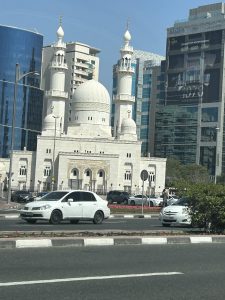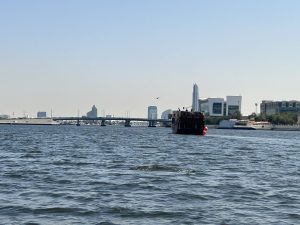Our cruise came to an end in the city of Dubai. As we left the ship, we were happy to have completed two of the five legs along the 2023 Island Princess World Cruise. After 55 days on board, this was actually the halfway point of the 110 day cruise and nearly double the length of time we had originally planned on being on board.
It was before 7am as our ship pulled into the port. The day began with a spectacular orange sunrise. Normally a red sky in the morning would be a warning for rain or stormy weather ahead, but Dubai sits in the middle of the Arabian Desert. With an annual rainfall of just 4 inches a year, there was little chance of seeing any moisture on this day. The sunrise was more likely being affected from the permanent haze caused by the blowing sands.
As we sailed past the “Atlantis Dubai”, an all inclusive resort and waterpark reflecting the “Lost City of Atlantis”, it quickly became apparent that we had arrived in a country of opulence. It is difficult to imagine that this city started as little more than a fishing village. It has now grown to be the most populated city in the United Arab Emirates Republic (UAE).
Most would assume that Dubai’s wealth was the result of oil. In fact oil and gas only account for about 2% of all exports! Real estate and construction are the largest contributors to the economic growth of the country. When 85% of the population is made from expats, it is easy to see why this is one of the fastest growing cities in the world.
Truth be told, I was a little nervous about visiting this city. This is a country with deep traditions and customs, many of which are quite different from our Western way of life. Mostly my concerns stemmed from my own ignorance about what to expect. A little research solved that problem. Perhaps by sharing our observations, we can help to dispel any concerns about visiting this amazing location.
1. The majority of the population is Muslim. This is a deeply rooted religion with different rules than those of Christianity. The most important “do” is to respect this. Part of being a world traveler is to immerse yourself in new cultures. Each new location presents an opportunity to learn, embrace it.
2. Muslims pause to pray 5 times a day. Prayers are before dawn (Fajr), afternoon (Dhuhr), late afternoon (Asr), after sunset (Maghrib) and evening (Isha). There are loud speakers throughout the city which call worshippers to prayer at regular intervals throughout the day. Don’t be alarmed when you hear the calls. Unlike in Christianity Holy day is Friday. This means many businesses offer limited hours on Fridays, if they open at all. Do plan accordingly.
3. Do take public transportation or use a taxi. We rented a car to explore the city and stressed ourselves out completely. Traffic on the seven lane highways is fast and a bit difficult. Our GPS had trouble distinguishing from when we were on a highway verses a frontage road, meaning we were often off course, which cost us precious time. Since we were only in the city for a little over 24 hours, we couldn’t spare any. The city is beautiful and there is much to see. Traffic is so busy you will not want to take your eyes off the road which means you will miss some of these spectacular sights. Take a taxi or take the Metro. If you choose to ride the train, it will be busy during rush hour. There are a few cars for women only. if you are male, don’t ride in these female only cars or you will be fined. Speaking of fines, do not eat or drink on the Metro, it is prohibited.
 4. Dubai is spread out with several distinct districts. Some are more difficult to access without transportation. Do know the district your hotel and/or desired activities are in.
4. Dubai is spread out with several distinct districts. Some are more difficult to access without transportation. Do know the district your hotel and/or desired activities are in.
5. With the exception of smoking cessation gum, you will not find gum for sale in Dubai so do bring your own if you need it. Don’t spit or throw your gum on the sidewalk, both are punishable crimes.
6. You are going to be hot, so do dress accordingly. Dubai is warm year around. The most comfortable time to visit is during “winter” months of December, January and February. You can still expect temperatures to be in the high 70’s (25C). At the opposite end of this spectrum it is up to 113F (45C) during the summer months! Light, loose clothing will keep you comfortable. Speaking about clothing, do remember you are a guest in these lands. Different from the western world it is expected that men and women both dress modestly to observe Islamic traditions, Knees and shoulders should be covered by both sexes. Don’t forget your sunscreen!
7. Do exchange some money. When using cash, only local currency (Emirati durham) will be accepted.
8. The best don’t is don’t worry about your safety (within reason of course). Dubai has an incredibly low crime rate.
9. Do not miss visiting the popular tourist spots! Be sure to see the Burj Khalifa, The tallest building in the world is an architectural wonder. The views from the 124th floor are slightly nauseating and completely awe inspiring. Do expect the lines to be long. If time is limited most of the tourist hot spots offer a “skip the line pass”. As an added bonus, the Burj is attached to the Dubai Mall which is another one of the must see locations in Dubai. We also suggest a visit to the Gold and Spice Souks, Old Dubai and the Miracle Gardens (which we completed all in one day).
10. Alan and I are very affectionate with each other, There is rarely a time when we aren’t holding hands. Public displays of affection are frowned upon in Dubai. In fact, if you are not married, even holding hands is frowned upon. It was a tough don’t for Alan and I to remember. Along these same lines, unmarried couples should not plan on staying in the same hotel room. Doing so, could lead to fines and/or deportation.
11. As a traveler it is fun to photograph different cultures. People can be so different but do be polite and ask permission before taking someones photo. Alternately you could take photos of other things and just happen yo capture the environment.
12. Don’t take pictures of Government Buildings. As we were cruising down the above waterway, there was a cool bridge just before our boat turned around to return us to our starting point. Shortly after taking this picture there were also numerous signs warning no photography beyond a certain point. I am not sure what lay beyond that bridge but if the Emirates might consider your photo an issue of national security, you really don’t want to be in trouble with the law in foreign lands. Do follow the rules, punishments may be strict for seemingly minor (and perhaps innocent) infractions.
13. Speaking about laws, Alcohol is available in most hotels, licensed restaurants and clubs. One thing is certain, the U.A,E does not tolerate public inebriation. Do not ever drink and drive, the legal limit is zero.
14. Finally, do not try to carry prohibited items. It is especially important to remember that you packed a pen knife in your carry on luggage before you pass through security at the airport. Failing to do so might bring a search of your bags and a very serious security agent to your side! Thankfully I wasn’t carted off to any back rooms. Do expect that you will be questioned and asked to surrender your “weapons”, if you forget.
Dubai is one of the most liberal countries in the Middle East. With the large expat community there is a tolerance for most differences. With these few simple guidelines you should have enough familiarity to feel comfortable in this amazing country.








